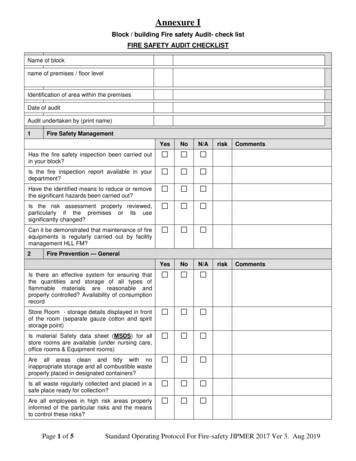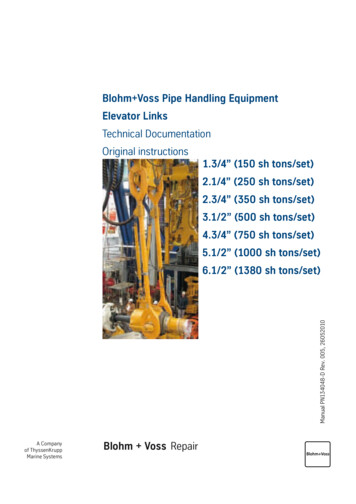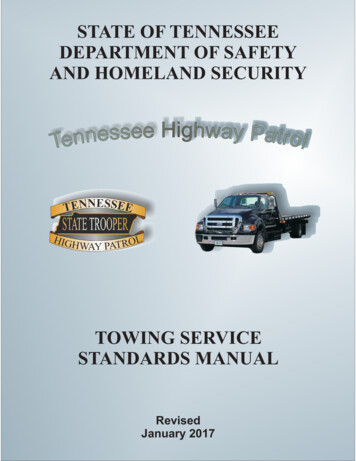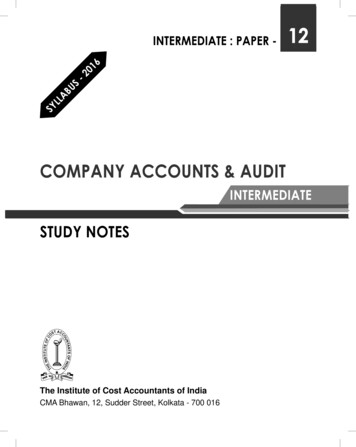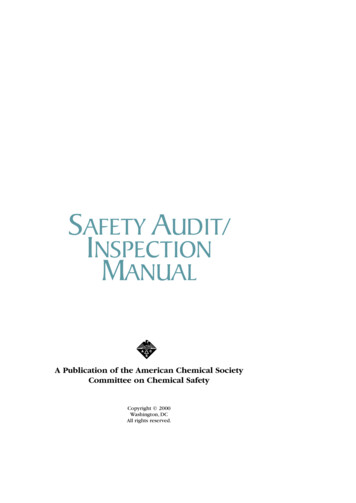
Transcription
SAFETY AUDIT/INSPECTIONMANUALA Publication of the American Chemical SocietyCommittee on Chemical SafetyCopyright 2000Washington, DCAll rights reserved.
PREFACEudits and inspections play ever-increasing roles in our workplaces.TheACS Joint Board Council Committee for Chemical Safety produced thismanual in response to numerous requests. In addition to being available inprint, this manual is the first to be published by the committee on the Web siteof the American Chemical Society.The Committee for Chemical Safety is pleased to introduce this manual andthanks the subcommittee that produced it. The subcommittee includes thechair, Stephen Sichak, Sr., and members Ann M. Norberg, Russell W. Phifer, DianeG. Schmidt, and Eileen B. Segal.We welcome all comments. Please direct them to the Committee forChemical Safety, American Chemical Society, 1155 Sixteenth Street, NW,Washington, DC 20036.AHenry C. RamseyChair, ACS Committee on Chemical Safety1998–1999ii
DISCLAIMERhe materials contained in this manual have been compiled from sourcesbelieved to be reliable and to represent the best guidelines and procedures for conducting a thorough safety audit and inspection in the workplace. This manual is intended to serve only as a starting point for managersand employees in their task of establishing good safety practices. The manualdoes not purport to specify any minimal legal standards or to represent anyspecific policy of the American Chemical Society. No warranty, guarantee, orrepresentation is made by the American Chemical Society as to the accuracy orsufficiency of the information contained herein, and the Society assumes noresponsibility in connection therewith. This manual is intended to provideworkplace managers with basic guidelines for conducting safety inspections.Therefore, it cannot be assumed that all necessary checklists, guidelines, andprecautionary measures are contained in this document and that other or additional information or safety measures may not be required or implemented.Users of this manual should consult pertinent local, state, and federal laws andlegal counsel before initiating any safety audit or inspection program and beespecially well informed about any compliance issues with respect to the handling of any hazardous chemical substances in laboratories.Tiii
TABLE OF CONTENTSINTRODUCTION .vi1. SAFETY AUDITS .11.1 ADMINISTRATIVE CONCEPTS .1Assignment of Responsibility.2Emergency Preparedness.2Employee Awareness,Acceptance of Responsibility, and Participation.2Identification, Control, and Monitoring of Potential Hazards .2Management Leadership .4Maintenance of Safe Working Conditions .4Medical and First Aid Systems.5Safety, Health, and Environmental Record Keeping and Statistics .5Safety Organization and Administration.5Safety Policy, Programs, and Activities.5Safety Rules, Regulations, and Procedures .5Safety Training and Education.61.2 PHYSICAL CONCEPTS .6Compliance.6Identification of Exposure .6Safeguarding Exposures .7Protection and Guarding .7Safety Organization .7Environmental Controls .81.3 PROTECTING YOUR AUDITS .92. SAFETY INSPECTIONS .10Inspection Teams .10Effective Safety Observation .11Starting the Inspection .11Inspection Team Obligations .12Inspection Procedures .12iv
Technical Problems.12Chemically Related Inspections.12Specialized Inspections.13Health Surveys .13Overhead Inspections.13Condemning Equipment.13Taking Notes .14Making the Report .14Handling Recommendations.153. SAFETY INSPECTION CHECKLIST .16Animal Handling and Biohazards.16Building Conditions .17Carcinogens .18Compressed Gas Cylinders .19Cryogenic Safety .20Electrical .20Emergency Evacuation and Equipment .22Employer Posting .23Environmental Protection.23Fire Inspection/Fire Protection.24Hand and Power Tools .26Housekeeping .26Laboratory Hazard Analysis .27Ladders.29Lasers .29Lockout/Tagout Procedures.30Machinery and Guarding .30Personal Protective Equipment .31Radiation Protection .32Signs and Tags .33Waste Accumulation.33Working Environment.334. APPENDIX .35Federal Laws and Regulations Affecting Laboratories.35v
INTRODUCTIONWhat is a safety audit? What is a safety inspection? Although the wordsaudit and inspection are frequently used interchangeably, they are notthe same.Broadly defined, an audit is a systematic review of operations and practicesto ensure that relevant requirements are met.Traditionally, the term audit isassociated with principles of accounting. Because of this, many people perceivea safety audit as an Internal Revenue Service (IRS) procedure or a financialaccounting procedure. Indeed, the safety audit may apply similar methodologies used in financial audits to mitigate safety risks within any facility or operation. A sound business enterprise must check its safety practices as carefully asits accounting records.The debits of possible loss or injury situations shouldbalance against the credits of adequate safeguards. Audits are not inspections.Audits evaluate all aspects of the program with special emphasis on the qualityas well as the quantity of safety and health activities at every level.The basicgoal of an audit is to verify that health and safety activities comply with institutional policies and federal, state, and local regulations.The Committee on Chemical Safety is well aware of the possible negativeperception of the word audit. Once you understand its meaning as used in thisdocument, you may, at your discretion, replace it with alternatives. Examples ofalternative terms include safety survey, safety consultation, safety assessment,field observation, field assessment, or operational survey. Throughout thismanual, the concept of environment, health, and safety is intended, but forthe sake of simplicity, safety is used. No matter what term(s) you use, youshould assign significant importance to the assessment of safety practices inthe workplace.Inspection, on the other hand, is defined as that monitoring function conducted in an organization to locate and report existing and potential hazardsthat could cause accidents in the workplace. Legally, the Occupational Safetyand Health Administration (OSHA) or the Environmental Protection Agency(EPA) conducts inspections.What we are discussing are discussing are surveys,not inspections. Safety surveys frequently reveal potential causes of accidentsand, thus, provide an opportunity to take corrective action before an injuryoccurs. Surveys are conducted at the line or operating levels; audits, on theother hand, are a managerial or corporate activity. Safety surveys are effectiveways of preventing accidents.You should take corrective action as soon as possible to abate all hazardsfound during an inspection. If the hazard presents an imminent danger toemployees, you must take corrective action immediately. If you must delay corrective action for nonimminent hazards, you should document the reason forthe delay and the estimated date of correction.When the corrective action hasbeen completed, you should document the action date.vi
1. SAFETY AUDITSafety audits are report cards on the success of safety andhealth programs, environmental programs, and processsafety management. Like financial and IRS audits, safetyaudits are structured evaluations on performance and compliance.A safetyaudit is a structured, methodical assessment and evaluation of how workplaceactivities affect safety and health. It reveals how an organization is doing inmaintaining a safe and healthy environment. Its goal is to ensure a safe andhealthy workplace by striving to eliminate unsafe practices and hazards thatlead to injuries and accidents.An audit consists of two parts: gathering data about a program and evaluating the data.The audited program must comply with a variety of regulationsand guidelines: federal environmental, safety, and health regulations; local andstate requirements; and internal institutional performance requirements.Governmental controls may include laws that cover environmental management, right-to-know issues, or process safety management.An audit should identify the strengths as well as the weaknesses of a program. It should reveal to management and the employees where and how theycould and should make improvements. On-site audits require three mainactions. First, arrange interviews with facility personnel who have key roles indeveloping or implementing safety management systems. Next, review documentation that defines safety system records or verifies completion of criticaltasks.These tasks may include emergency preparedness; hazard identification,control, and monitoring; and safety education and training. Last, conduct fieldassessment of the facility or equipment. Here, the assessment might includeverification of implementation of safety practices. For example, are only certified welders performing hot work (welding)? Does he or she have hot workpermits?Audit data, obtained by reviewing written records and procedures, interviewing personnel, and personal observation, are collected from both anadministrative area and a management or operational area, which controls thephysical environment.Audit of the administrative area includes a review of howwell or how poorly management has implemented the program. Audit of theoperational areas, whereby management controls the physical environment,includes assessing the surroundings and external conditions that influence thedaily operation of the organization.S1.1 ADMINISTRATIVE CONCEPTSIn its broadest terms, an audit includes all or some of the administrativeconcepts described in this section. Some of these concepts are provided toestablish a “Framework for Evaluating Safety.” The following information provides a framework for developing evaluation criteria. It should not be used as achecklist, which can be limiting.1
Assignment of Responsibility Are department heads, supervisors, and staff assigned safety responsibilitiesas a policy or procedure, and is the policy communicated to all levels? Is there a clear line of responsibility? Who is responsible for coordinating the compliance program? What steps has the organization taken to comply with OSHA and otherregulations? Is the safety staff competent and qualified? Is safety responsibility monitored?Emergency Preparedness Does the employer have an emergency action plan? Is it testedby drills? Do personnel receive training on the proper way to reportemergencies and summon help? Does the organization have an emergency response procedure,including backup systems for controlling spills and releasesand evacuating personnel? Are procedures in place for reentry and cleanup?Employee Awareness, Acceptance of Responsibility, and Participation Is there active participation in a safety and health committee? Are the engineering and administrative controls effective? Is there an effective personal protective equipment program? What type of equipment is used? What is the rationale for use? What are the maintenance procedures? Is equipment available to and used by all employees? Is mandated training performed? Is there safety publicity (newsletters, bulletins, etc.)? Discipline: Are violators of safety rules disciplined? Are supervisors setting a good example? Is the safety and health performance effective?Identification, Control, and Monitoring of Potential Hazards Is top management aware of all health and physical safety risks in the workplace? Hazardous substance control program: Is one in use? Are all substances identified? Are employees aware of the risks? Are procedures in place to inform and educate employees about all healthand physical safety risks? Does this procedure include informing employeesabout the potential hazards of nonroutine tasks and educating contractemployees about potential hazards on-site? Do employees receive testing toensure that they understand what they learned?2
Does the employer provide written information and training procedures? Does the employer document information and training session outcomes? Doemployees sign attendance sheets and state in writing that they understoodthe material presented? Does it document who was trained, when they weretrained, and whether they successfully completed the training? What procedure is in place to coordinate documentation of training materials? Are thetraining logs entered into a database? How are the original sign-in sheetsstored? Are they easy to retrieve? Is a knowledgeable person assigned responsibility to determine the presenceand use of hazardous materials? Is a list of all hazardous substances available? Have suppliers provided material safety data sheets (MSDSs) covering hazardsand precautions for all chemicals? Are these MSDSs available to all employees on request? Is every nonexempt container of hazardous chemicals in the workplaceappropriately labeled? The hazard communication standard generally applies only to thosechemicals (including elements, compounds, and mixtures) to whichemployees are exposed in the workplace under normal conditionsor in a foreseeable emergency. Hazardous wastes regulated by the U.S. Environmental ProtectionAgency (EPA), chemicals produced and used only in a laboratory, anditems for personal consumption are exempt. Piping and containers into which an employee transfers hazardouschemicals for use during that workshift are exempt from the labeling requirement. How does the safety coordinator find out when a new chemical is introduced into the workplace? How does the safety coordinator ensure thatunused chemicals are disposed? For every known health hazard, does a definite control plan exist that covers periodic monitoring of the hazard? continued maintenance and monitoring of employee exposurerecords? periodic physical examinations for employees in exposure areas?Is strict enforcement of rules governing provision, care, and use of personalprotective equipment followed in all cases? Is a list of symptoms and antidotes for toxic substances circulated and postedwhere necessary? Are known health exposures studied to eliminate or reduce exposuresthrough process or design changes or engineering controls? How are suchstudies conducted? How are the results communicated? Do employees understand and comply with OSHA standards or safe practicesrecommended by manufacturers or other agencies? Have certified industrial hygienists evaluated the operations? What actions are taken regarding recommendations made by industrialhygienists? What actions still remain to be taken?3
Are safety rules and approved signs relating to health hazards posted in areaswhere hazards are present? What is the procedure to confirm that supervisors and employees exposed topotential health and safety hazards understand the nature of the risks, thepreventive measures, and related safety rules? What evidence is there in the workplace that the hazards are known and adequate controls are in place and working? Are appropriate safety devices available? Is personal protective equipment(PPE) provided and used properly? Is PPE in conformance with appropriate standards such as NIOSH (NationalInstitute for Occupational Safety and Health) or ANSI (American NationalStandards Institute)?Management LeadershipFundamentally, all safety work must proceed from the proper motivation ofmanagement.The effectiveness of any program increases or diminishesaccording to the degree of support and encouragement that managementdisplays. Is there a written safety policy/program? Is employee participation solicited? Is management setting a good safety example? Is off-the-job safety a management concern? Is there a systematic review of safety performance? Do safety issues flow down from management or up to management? To whom in top management does the chief safety coordinator report? Are adequate funds made available to support the safety program? correct unsafe conditions? support training and other educational activities? Are new employees indoctrinated with safety and health training by management’s edict? Are they then tested to ascertain that the safety andhealth training is inculcated?Maintenance of Safe Working Conditions Is there proper maintenance of good housekeeping conditionsin the workplace? Are equipment and materials organized andadequate? Are work areas and the exterior of the plant clean? Workplace inspection program: What is the frequency of inspections? Who performs them? Is a record maintained? Is there a preventive maintenance program? Are the inspection team personnel trained? Are the engineering and/or administrative control programs routinelyevaluated?4
Medical and First Aid Systems Does the employer have an emergency action plan? Does the employer have first aid and medical treatment available for emergency response? Are adequate first aid and emergency facilities available? How is adequacy determined? Does the employer have access to a consulting physician? Is the consulting physician certified in occupational health practices? Is the program under the supervision of a physician certified in occupationalmedicine? Does the program regularly review and monitor illnesses? Is there a program that regularly reviews and monitors medical examrecords? Is the program under the supervision of a certified physician?Safety, Health, and Environmental Record Keeping and Statistics Is the record keeping responsibility assigned and implemented? Is the OSHA 200 log up-to-date? Are facilities and equipment inspection records kept? Are environmental monitoring records (for noise, dust, heat, radiation, etc.)kept? Are training records kept? Are medical records complete? Are accidents and occupational illnesses evaluated? Are policies and procedures changed as necessary?Safety Organization and Administration Is there a clear line of responsibility? Is there a budget for time and expenses for a safety program? Is the safety staff competent? Is safety responsibility being monitored?Safety Policy, Program, and Activities Has the safety policy been issued and communicated? Is there a safety committee? How is membership determined? How frequently do members meet, and what are the topics of the meetings? Are the minutes of the meetings recorded? What type of safety program does the facility have? Who is in charge of theprogram? Are adequate funds made available to support the safety program, correctunsafe conditions, and support training and other educational activities?Safety Rules, Regulations, and Procedures Who is responsible for knowledge and maintenance of an up-to-date fileon applicable federal, state, and local laws, regulations, and ordinances? Are these laws, regulations, and ordinances communicated to all keypersonnel? Who ensures compliance?5
Are institutional and departmental safety rules issued and communicated toall employees? How is it ensured that these safety rules will be followed? Are types of personal protective equipment and the rationale for use communicated to all employees? Who maintains personal protective equipment?How is it ensured that the maintenance is performed in a timely manner?Safety Training and Education Employee safety education and job safety training: What is the frequency of the meetings? What topics are covered? Which types of jobs require safety training? Supervisor safety training: What types of training are required? What subjects need to be covered? What is the frequency of the meetings? Is attendance mandatory and/or recorded?1.2 PHYSICAL CONCEPTSMaintenance is an essential element of safe working conditions. A safe andhealthy place to work is the foundation on which every successful safety program is built. To provide such a workplace requires control of the physicalenvironment—the surroundings and external conditions that influence thedaily operation of the establishment, including the possibility of injury toemployees. Control of the physical environment is management’s responsibility.The organization and administration of every safety program require that management makes a complete and competent effort to provide a safe workplace.The importance of a safe physical environment cannot be overemphasized.Physical concepts to be considered include the topics described in the following section.Compliance Is there compliance with federal, state, and local laws, regulations, and ordinances? Who has been assigned responsibility for coordinating the compliance program? What steps has the company taken to comply with OSHA and other regulations? Have priorities been established regarding corrections of known OSHA andother violations? Is the safety program thoroughly documented, and will it be useful to helpdemonstrate a positive safety attitude?Identification of Exposures Are known health exposures studied to eliminate or reduce them in thefuture through process or design changes or engineering controls?6
How are such studies conducted, and how are the results communicated? Are all containers of hazardous materials properly labeled? Are there knowledge of and compliance with OSHA standards or safe practices recommended by manufacturers or other agencies?Safeguarding Exposures Is there evidence in the workplace that hazards are known and adequatecontrols are being implemented? Are appropriate safety devices and PPE provided and used properly? Is PPE in conformance with appropriate standards such as NIOSH and ANSI? Are defective tools, equipment, and/or materials recalled, repaired and/orreplaced?Protection and Guarding Are all accessible belt and chain drives well guarded toprevent personal contact? Are all machines, fans, and foot switches guarded asrequired? Are all accessible hot surfaces guarded to prevent thermal burns? Are the guards in proper position on the bench grinder, and is the tool restclearance properly set? Are guards in place on paper cutters? Are pump couplings guarded to prevent splashes? Are vacuum desiccators and other glass apparatus being used under a vacuum properly guarded, coated, or taped? Are all areas where special PPE must be worn (goggles, face shields, specialfootwear, hard hats, respirators, gloves, and body protection) clearly marked? Is the special PPE in good condition (sanitized, etc.) and readily available? Where compressed air is supplied, do all hoses and fittings comply with theservice requirements, and is the pressure properly reduced at the point ofuse?Safety Organization Are all safety activities coordinated by one individual? If not, how are safetyactivities coordinated? Does the safety coordinator report directly to topmanagement? Does the coordinator have direct access to all levels of operating management? Does the coordinator provide progress, accident analyses, status of recommendations, and other reports to management regularly? Does the coordinator make specific recommendations for management’saction? What are the time commitments of the coordinator in relation to the following items:7
What percentage of time is spent on safety?What percentage of time is spent on other duties?Are accident statistics posted for review by all employees?Is information on specific accidents, their causes and correctiveactions, ever publicized? Are any awards given for good accident records, and are such awardsgiven wide publicity? Has management established a safety suggestion system? Are employeesencouraged to make suggestions or complaints on safety matters? Are theyrewarded for making such suggestions?Environmental Controls Is the workplace free of odors that may indicateunhealthy conditions? Is there adequate control of noise level while work isunder way? Is the workplace reasonably clean and free of debris,spilled materials, dirt, etc.? Is lighting and illumination satisfactory in all areas? Are rules pertaining to food and drink in the workplace being followed? Are guidelines for restraining long hair when operating a machine posted andfollowed? Are guidelines regulating loose sleeves and dangling jewelry while operatinga machine followed? Are “no smoking” rules followed? Are there at least two persons present in all work areas where workers arenot permitted to work alone? If employees climb up off the floor, are they using an approved ladder orportable platform? Are razor blades, knives, and other sharp tools of the proper type for theirintended use? Are they used and stored in accordance with suitable guidelines? Are all tools in good repair? Are all required caution and warning signs posted? Are wastes deposited in the proper containers?8
1.3 PROTECTING YOUR AUDITS Is an audit a protected internal document? How much information is available to the public? What does the public have a right to know? What does the government have a right to know? Does the government have the right to view audit reports? Can regulatory agencies use information found in these reports?Currently, both the U.S. Department of Justice and the EPA have policiesstating that they will not review audit reports during every investigation butstill reserve the right to do so. OSHA, on the other hand, has taken the positionthat it may use voluntary audit results obtained during an inspection of a facility. It may use the results not only to determine if violations have occurred butas a potential basis for alleging that violations were committed willfully.Thisposition is especially true in those cases in which it is evident that the employer was aware of hazards but did nothing to resolve the exposure.9
2. SAFETY INSPECTIONSafety inspections are a basic tool for establishing andmaintaining safe conditions and discovering unsafepractices in t
ACS Joint Board Council Committee for Chemical Safety produced this manual in response to numerous requests.In addition to being available in print,this manual is the first to be published by the committee on the Web site of the American Chemical Society. The Committee for Chemical Safety is pleased to introduce this manual and


